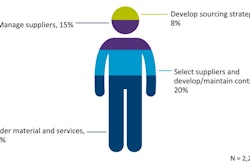
The Coronavirus disease (COVID-19) has had an immense impact on supply chains around the world. In fact, almost 75% of U.S. businesses have experienced disruption in their supply chains. As a result, the way organizations acquire the goods and services they need to survive seems less like a well-oiled machine and more like a house of cards.
Regardless of industry, size of business and geography, businesses are struggling with widespread procurement disruption. Overcoming supply chain management challenges moving into 2022 will take a precise approach, forcing organizations to become more agile than ever before.
Understanding the impact of disruption on supply chains
While it may feel like we’re nearing the end of the pandemic for some, many parts of the world continue to struggle with its impact. And, it may be a while before the full scale of its effects is understood.
Despite the push for many organizations to “move on,” it’s important for businesses to reflect on the impact this disruption has had on their supply chain.
How organizations need to view supply chain disruptions
Poor vendor performance, workflow slowdowns, manual entry errors and transportation disruption are common in supply chains. For the longest time, organizations simply analyzed supply chain efficiency from a cost-cutting perspective.
That has changed.
Businesses now need to look at major disruptions as a real possibility and plan accordingly.
Preparing for the unexpected
Optimizing your supply chain is now about survival. Businesses need to be prepared for rapid, major shifts. Integrating and automating platforms and services will need to be the norm.
As the world continues to become more chaotic, streamlining the supply chain is no longer a “nice to have.” It’s essential.
While major disasters are rare, their impact is now more prevalent than ever. We live in a hyper-connected world. Data moves faster than ever. And with it, customer expectations and agility have grown, too.
If your supply chain is inefficient on any ordinary day, it will fail when major disruptions happen. And, while you’re left scrambling to find solutions, your competitors will be out-pacing you.
The need for transparency
You cannot effectively manage your supply chain without real-time analytics. Every action in the supply chain generates data. Your ability to capture and interpret in a meaningful way can help you rapidly adjust to major problems with minimal disruption.
The struggle most businesses face is gathering data quickly and interpreting it in a meaningful way. The key here is to invest in better data dashboarding. Connecting your internal systems with your vendors and getting insight into your entire procurement process is essential.
With real-time insights, your business will become more agile than ever. You can track distribution, re-route transportation to avoid breakdowns, communicate with vendors clearly and rapidly shift your supply chain to avoid major disasters altogether.
Better risk assessment
While it’s important to be agile, it’s equally important to understand how to manage risks properly. Over optimizing your supply chain can be just as costly as allowing disruptions to happen.
For example, stockpiling inventory for a potential catastrophe that never happens can burn through the budget in product, transportation and warehousing costs. Alternatively, not preparing for customer behaviors like panic-buying with increased inventory can create a negative impact.
To avoid this, you need to assess risks properly and leverage experience and insights to make informed decisions that impact the supply chain.
Perform audits on your supply chain. Attempt to identify weaknesses (social, environmental and political). Conduct stress tests on your suppliers to see where their weak points are and how relationships, pricing, logistics and production are impacted by increased strain.
You also want to build out a supply chain emergency plan and base it on your organization’s needs and experiences. And, keep it up to date. This will give you something to fall back on when the next major disruption happens.
You should also increase your supply chain agility. Don’t put all your eggs in one basket. Instead, diversify suppliers. And, have backup suppliers vetted and ready in case you need to rely on them to move materials.
The benefits of being adaptive
How your business navigates supply chain disruptions will have a lasting impact on the organization both from within and outside.
Your team members want to work with an organization that doesn’t shut down due to problems in the supply chain. Being able to keep goods and services moving into the organization despite challenges communicates and underscores your company’s resilience.
Customers also judge an organization based on its ability to deliver in challenging times. And, if your competition outpaces you because they can manage supply chain disruption better, you’ll risk losing customers as well.
Leverage the right tools
The more agile a business is, the more ready it is to adjust to major disruptions in the supply chain. But, that’s easier said than done. For an organization to succeed, it needs access to the applications that help it scale, reduce waste and get more time to make strategic decisions.
There are a multitude of supply chain tools on the market. Many of these out-of-the-box solutions are designed to streamline processes in the supply chain and provide more insights. Custom applications also make a business more agile as they fit its precise needs.
However, both of these solutions often come with enterprise-level price tags that leave SMEs struggling to survive. What’s worse, these solutions eat away cash reserves, leaving you even more vulnerable to the consequences of supply chain fluctuations.
That’s not to say your organization shouldn’t invest in better systems. It should just do so carefully. The key is to assess your needs and find appropriate platforms that can strengthen the supply chain without bankrupting the business.
Other growing solutions are low code and robotic process automation (RPA). The ability to rapidly build and deploy custom apps using drag-and-drop interfaces gives growing businesses with limited resources the ability to match the efficiency of large-scale organizations.
Deploying these technologies allows organizations to hyper-automate, or rapidly streamline as many business processes and systems as possible. For a smaller company, this can give them a huge advantage as it allows them to scale rapidly without the high costs associated with custom application designs.
Streamline business processes
It goes without saying that organizations need to do more moving into 2022 to better prepare for major disruptions. To do that, they need the right data and more time to analyze that data. Without both, they’re left hoping they can survive whatever the world throws at them next.
The key to getting more time and resources is to automate the workflows in your organization. By reducing operational inefficiencies, you make your business more agile.
The time and resources you gain from workflow improvements can be reallocated into focusing on how to make your supply chain more resilient.
Even better, use that time to actively monitor potential disruptions. Identifying issues as they happen (or predicting them and adjusting accordingly) will be the only way for businesses to navigate supply chain management issues in the future.

![Pros To Know 2026 [color]](https://img.sdcexec.com/mindful/acbm/workspaces/default/uploads/2025/08/prostoknow-2026-color.mduFvhpgMk.png?auto=format%2Ccompress&bg=fff&fill-color=fff&fit=fill&h=100&q=70&w=100)







![Pros To Know 2026 [color]](https://img.sdcexec.com/mindful/acbm/workspaces/default/uploads/2025/08/prostoknow-2026-color.mduFvhpgMk.png?ar=16%3A9&auto=format%2Ccompress&bg=fff&fill-color=fff&fit=fill&h=135&q=70&w=240)










